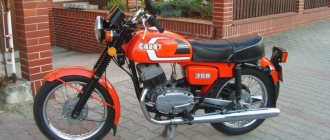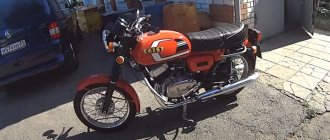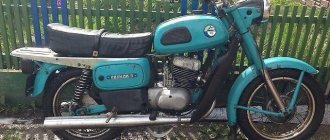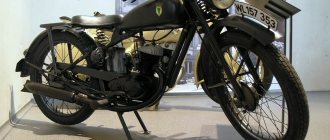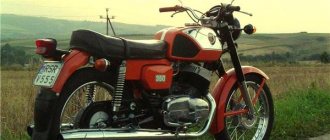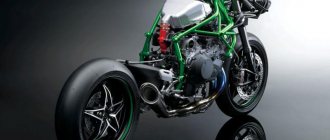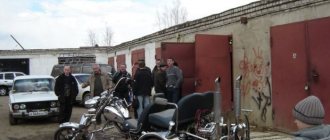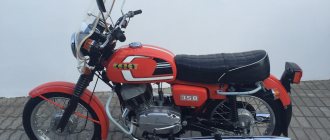The Chezet 350 motorcycle was the dream of thousands of Soviet bikers at night. And all because Czechoslovak motor vehicles were beyond the means of most of them, and it extremely difficult to get a CZ or Jawa . Since then, everything has changed, the Chinese and Japanese flooded Russia with hundreds of new models, and the veterans of the Soviet era were gradually forgotten. And completely undeservedly! They may not be able to compete with modern competitors, but in the USSR they were one of the best , despite the fact that their production stopped in 1989.
Design
The production of this model was launched at the Cezet plant in 1976 , and the basis for the new bike was taken from the manufacturer’s previous models, largely copied from the German DKW NZ350, the resemblance to which is visible even in the photo. The appearance of the Ceseta 350 is completely consistent with its era, and now it can be called an example of vintage style. No plastic, only honest iron, chrome and aluminum! The CZ 350 is one of the role models for modern manufacturers producing retro-style motorcycles.
How the CZ 350 came to be
The CZ arms factory in Czechoslovakia enjoyed good popularity. The weapons made by specialists from this plant served for a long time and faithfully. In 1929, new machines designed for the production of cars and motorcycles appeared in production. The first motorcycle of this plant was created based on the German model DKW NZ 350.
In 1930, the plant officially released the first motorcycle called the CZ 350. It was designed for riding on rocks and difficult terrain. The technical characteristics of the Chezet 350 motorcycle greatly pleased the drivers. In subsequent years, new modern models were released. Based on the Cheset 350 principle, motorbikes and sports motorcycles were also created.
During World War II, motorcycle production stopped and the arms factory began working again to produce weapons. Motorcycles produced before the war delivered weapons, food and medicine to the battlefield. Statistics show that during this time, despite all the shots and attempts by the Nazis to blow up vehicles, out of 500,000 motorcycles, only 200 were completely damaged. Thanks to high-quality materials and the hard work of specialists, motorcycles of this model still work to this day.
After the end of the war, the production of motor vehicles resumed in 1945. The plant decided to improve the quality of the motorcycle by first increasing the engine capacity - 250 cm3, and then 344 cm3, and changing its design by adding an additional cylinder. Thus, the vehicle received a two-cylinder two-stroke engine with a volume of 344 cm3.
Specifications
For its era, this bike had excellent characteristics that made it convenient for use both on and off the road. In general, a motorcycle with the same name was produced back in the middle of the 20th century, but the few surviving copies are now gathering dust in museums, so in the 70s this model was actually designed anew. This worked to her advantage, and CZ began to rightfully be considered one of the most reliable brands in the USSR.
Engine
The two-cylinder 2-stroke air-cooled engine cannot boast of impressive performance; it produces only 23 hp. at 5250 rpm , but half a century ago it was very, very cool! Even now, it is quite capable of driving vigorously at speeds of up to about 120 km/h , although much depends on the technical condition of a particular instance. True, the engine life is short, like all other Soviet two-stroke engines, so it’s definitely not worth using this historical value on two wheels for routine trips to buy beer at the nearest store.
Transmission
Czechoslovakian engineers equipped the Chezet 350 with a 4-speed transmission . Nowadays it’s difficult to surprise anyone with such a decision, but in those days it was an excellent engineering solution, since even in those years many motorcycles were still produced with a 3-speed manual transmission. It’s also a matter of amazement and immense respect that the bike even now easily and smoothly shifts gears, if, of course, the previous owners looked after it properly.
Chassis and brakes
The CZ 350 motorcycle is designed using advanced technologies from 50 years ago. This automatically means a simple steel frame, practically unable to resist bending and torsion, drum brakes and suspension , comparable in efficiency to an I-beam. Well, what more can you ask for from a motorcycle that is older than most Russian bikers?
Electronics
There is absolutely no complex technical content in this model. In those years, no one had heard of auxiliary electronic systems, so all on-board electronics came down to a coil of wires, a generator, spark plugs and a couple of light bulbs. The Java and Chezet motorcycles of that era were no exception to this rule.
Weight and dimensions
In those days, no one thought about ergonomics - it goes, and okay, it’s already good! Therefore, the CZ 350 motorcycle turned out to be large, angular and quite high in the saddle, and besides, it’s easy to burn your leg with the engine protruding from the frame. curb weight is about 170 kg , and all of these kilograms are felt if you drop the bike and then try to pick it up. On the go, however, this mass is not felt at all.
Controllability
The closest analogue of the Chezet 350 in terms of handling will be some modern Chinese small-capacity car. The motorcycle more or less obeys the steering wheel, copes well with Russian roads and is able to at least somehow brake, but that’s all that can be said here. Considering the advanced age of the model, this is already a good achievement.
Fuel consumption
The exact numbers depend on the condition of the motor and other components. The CZ350 without a sidecar has an average consumption of about 5 liters per 100 km , which, in combination with a 13-liter gas tank, gives the Czechoslovakian bike a power reserve of more than 200 kilometers. The engine can easily digest even AI-76, which has not been produced for a long time, so you can safely fill the tank with AI-92. But it’s better to refrain from using high-octane fuel, otherwise the valves may burn out! And you need to remember to add oil to gasoline, the engine is two-stroke .
Modern edition
The modern production of CheZet motorcycles is very diverse. You can purchase a sports or classic type of motorcycle.
These models are produced for driving: amateur and professional.
These motorcycles are made using motors that have increased power and torque. Light weight. You can create fast dynamics during acceleration.
The classic version of CheZet motorcycles is considered to be a model with an engine capacity of 350 cm3. In terms of technical characteristics, these motorcycles are similar to Java motorcycles.
Therefore, many parts of these two brands of motorcycles are interchangeable. In 1973, these 2 companies merged to jointly release.
The most popular and best-selling model of the CheZet motorcycle is the CZ (CheZet) 350 12v.
This model belongs to the tourist class. 23 hp motor. With. A 4-speed gearbox is used. The engine speed is squeezed to the maximum - 5000 rpm.
The equipped motorcycle weighs 155 kg. The gas tank is designed for 13 liters.
In order to participate in off-road racing, another type of CheZet was developed: the 550.
This model is used for off-road driving and can accelerate quickly.
Purchased by racers who have been participating in such races for a long time.
Beginners who have recently mastered the CheZet touring model are not able to operate such a model.
This motorcycle has 40 hp. It uses a 6-speed gearbox to control the engine's maximum speed.
It can accelerate quickly and does not require special skills to handle. Consumes up to 6 liters of gasoline per 100 km of driving.
The Yamaha JOG RR sports scooter often becomes a winner in races; it will appeal to those who want to get the most out of their equipment.
Kawasaki Versys 650 technical characteristics of a Japanese bike, enduro class.
Motorcycle price
Due to the rarity of the model, surviving copies are not cheap, and therefore are of interest mainly to connoisseurs and collectors. The choice is small; on popular sites you can usually find at most a dozen offers for sale at the same time. The cost of a bike with documents and in a living condition starts from about 150 thousand rubles , but a well-restored motorcycle can cost twice as much.
How much can you buy a CZ-350 for and is it worth it?
Buying a Chezet motorcycle is quite difficult.
They do not have any collectible value, but due to their rarity they sell at a high price. Prices start at 75,000 and end at 600,000 rubles for an ideal. If you search, you can find good working copies for 150,000. As collectibles, you'll have to work on them, and riding tattered junk is a dubious pleasure.
Buying such a motorcycle is too expensive. Any Soviet bike is difficult to restore, but this Czech bike is rare. With Java it will be several times easier and cheaper.
The motorcycle looks best in red. Photo: Youtube.com
But if you have memories of your youth associated with Cheset, you can try, some people succeed!
Repair and tuning
From a purely technical standpoint, anyone who has at least some experience in repairing and servicing motorcycles can understand the design of the Chezeta 350. And, most likely, the owner will have to do this personally, since now there are few craftsmen left who know the technology of the Soviet era inside and out.
Repair
Repair and service operations are not difficult at all. A standard suitcase with tools for 3-5 thousand rubles is enough to disassemble the bike to the state of “a frame and two bags of spare parts in the corner”, and then put it back together. Unless, of course, you have a repair manual at hand, and your arms grow approximately from the shoulder area.
Spare parts
Finding spare parts for the Chezet 350 is now difficult because they have been out of production for about as long as the motorcycles themselves (production of spare parts ceased around 1990). But just buying a motorcycle is not enough, you also have to maintain it! So it makes sense to get involved with this rare model only for those who have a clear idea of what awaits them.
Tuning
In the Soviet Union, tuning usually came down to installing arches and luggage systems, most often homemade, and new owners of ancient ChZ 350s usually get rid of this inheritance as soon as the motorcycle falls into their hands. A person who would like to take such a two-wheeled old man to turn it into a “sportbike type” or “chopper type” should be beaten with a stick until it dawns on him that such motorcycle equipment must be handled with the same care as Chinese porcelain vase from the Qin Dynasty. Only restoration, only hardcore!
approximate cost
It is very difficult to talk about a specific price for this device. Everything depends primarily on the condition of the frame and the technical condition of the bike; we must not forget about the availability of all the necessary documents. On the Russian market, the price for this model starts from 10,000 rubles. Motorcycles sold are as early as 1988 or older.
An inspiring video of a Triumph motorcycle; when watching, you can feel the reliability and power of this bike.
A modular helmet for a snowmobile has undeniable advantages for use in winter.
Motorcycle modifications
In the 30s, about a hundred years ago, a bike with the same name was produced, but these days it is a museum rarity. The Chezet 350, which is the subject of our review, was produced with minor changes from the mid-40s until 1960. The copies of different years of production differed mainly in small details. A version with a side stroller was also offered to buyers . Later, already in the 80s, after the unification of the Java and Chezet brands, the Jawa-CZ 350 model was produced, but Java Chezet is a completely different motorcycle .
Photo gallery
Introducing the iconic CZ 350, a true legend of its time. There wasn't a single teenager who didn't want to buy this bike. We have made a small selection of photographs especially for you.
Advantages and disadvantages
It is incorrect to compare the technical characteristics and driving performance of the CZ350 with modern technology, since these are motorcycles from different eras. But you can try to compare it with Soviet motorcycles produced around the same years - this will be more objective. In any case, in the modern world, this model usually stands in the garage, where the dust is carefully wiped off with a cloth, and is not used for its intended purpose.
Advantages
- High reliability . No wonder Jawa and CZ were wildly popular among Soviet bikers! In terms of fault tolerance and service life, Czechoslovak motorcycles have always been head and shoulders above Voskhods, Minsks, Urals and others.
- Maintainability . If you have straight hands and a burning desire to feel like a motorcycle mechanic, you can fix absolutely everything on this bike.
- Possibility to attach a standard stroller . If, of course, you manage to find it on sale.
Flaws
- Age . Unfortunately, it takes its toll, so it’s difficult to find a bike in good condition, especially for a reasonable price.
- Difficulty finding spare parts . Nothing is impossible, but the new owner needs to prepare for the fact that he will have to search for everything he needs on forums and message boards.
- Weak brakes . However, drum brakes were quite adequate for the 70s.
Motorcycle CZ 350 (Chezet 350) – detailed review
This review will focus on a motorcycle that was very popular during the Soviet Union, as well as beyond its borders. The CZ 350 motorcycle (Chezet 350) is a cult bike, which is characterized as reliable transport. The world recognized the Czechoslovakian manufacturer as a reliable supplier of motorcycles, after famous victories in such disciplines as Enduro and Motocross. But, Chezet 350 was rightfully considered a touring motorcycle. It was this unit that made it possible for tourists of that time to discover new horizons.
Owner reviews
I had a Chezet 350 in my youth, it was a fairy tale, not a motorcycle. Now, of course, I already understand that this is all the hoary antiquity of the shaggy years, but compared to other Soviet motorcycles, it was simply heaven and earth)) It broke down, of course, not without this, although the motorcycle was then 12-15 years old or so that... But the warm memories still remain. Igor, Yekaterinburg.
There are currently three 350s in the garage, one is being restored, the other two are donors, plus a Vyatka scooter. I’ve been working for several years in my free time, restoring everything to the original, during this time I’ve already invested about 200k, but I don’t mind buying my favorite toy. Last summer, in good weather, I already took the Czech out for a ride, it works like clockwork, despite its age. Although there is less than 2000 km on the speedometer, and it is 100% not twisted. Anatoly, Novorossiysk.
It was a good unit for its time, although our Izh Planet Sport is still better, I owned both, so I can judge objectively. The chain, by the way, is heavy, easy to drop, the center of gravity is high. But it is very durable, runs for a long time without repairs, the piston engine has a service life of about 20 thousand. Sergey, Orel.
Similar models
- Jawa 350. The most famous motorcycle in Czechoslovakia (and later the Czech Republic), produced in one form or another until 1992.
- Jawa-CZ 350 . A product of unification of two brands, slightly less old than the hero of our article, but still very rare.
- Izh Planeta 5. Technical characteristics are similar to the CZ350, it was produced until 2008, so finding a copy in decent condition is much easier, and it will cost several times less.
FAQ
- Are parts from Java suitable for it? Depends on which one. Due to the unification of production in Czechoslovakia, motorcycles of these brands actually have the same components. But spare parts for the old Java are not so easy to find these days.
- Is it possible to make the cradle from something else? From “Izha”, for example? It is possible, but is it necessary? A non-standard stroller will not fit into place without any problems, and besides, such a solution will completely kill any attempt to restore the old bike to its original condition.
- What kind of oil should I put in the tank along with gasoline? The recommended brands have not been produced for a hundred years. Any modern oil for two-stroke engines is suitable. Better quality, but this is not critical. In the USSR, they usually added M8B oil to gasoline, which a normal person would disdain to lubricate door hinges, and nothing, they drove around somehow.
Description of the classic motorcycle Chezet 350
The first motorcycles appeared in 1930. It was developed by specialists from the city of Czechoslovakia.
This motorcycle was first released from the CZ factory, at that time weapons were manufactured there.
In 1932, the first motorbike was created, which was equipped with a 76 cm3 engine.
In 1933, a cross-country model was released. A 100 cm3 engine was used. After this model, a motorcycle was developed, which was equipped with a 3-speed gearbox and an engine (175 cm3).
In 1936 with 250 cm3. From this model, 2 models were created: - 2 - x cylinder unit with 500 cm3; — 1 — cylinder with 350 cm3.
After the war ended, the production of Cezet motorcycles was resumed. They were produced with a telescopic front fork.
Later a version with rear spark plug suspension was used. In 1950 The production of motorcycles from this company was established.
They were equipped with 2-stroke engines with 123 and 148 cm3. From 1962 to 1965 Java and Chiset were sold on the USSR market. They were very popular at that time.
In 1990, the plant was bought by the Italians. Road motorcycles of 2 types began to be produced: - 2-stroke with 124 cm3 with a Cagiva engine; — 4-stroke with 200 cm3 with CZ engine.
Conclusion
The Chezet 350 may have been a modern motorcycle for its time, but its time has passed. Now it is a collector's value , and the value of surviving copies will undoubtedly only increase from year to year. So if, after reading this review, your desire to become the owner of this device has not disappeared, it is better to hurry - next year it will most likely be even more expensive to buy your dream.
Specifications
| Maximum engine power: | 23/5250rpm HP |
| Working volume: | 343.3 cm3 |
| Motor type (cylinder arrangement, number of strokes): | 2-cylinder, 2-stroke, in-line |
| Number of cylinders: | 2 |
| Number of valves: | |
| Intake type (Injector / Carburetor): | |
| Bore and stroke: | |
| Starting system (Electric starter, kick starter): | |
| Maximum speed in km/h: | 131 km/h |
| Cooling system: | Air |
| Transmission (gearbox): | Mechanical 4-speed |
| Clutch (Dry / Wet): | |
| Drive unit: | Chain |
| Frame: | Steel tubular |
| Chassis | |
| Suspension (front/rear travel): | |
| Brakes (Front/Rear): | |
| Wheels / Tires / Rubber: | |
| Dimensions and weight | |
| Dimensions (Length / Width): | |
| Seat height: | |
| Ground clearance: | |
| Curb weight: | |
| Weight: | 171 kg |
| Fuel tank capacity: | 13 l. |
| Battery capacity: | |
| Year of release: | |
| Country of Origin: |
Main differences from previous models
- Spacious fuel tank.
- Upgraded telescopic forks at the front (with black boots).
- Installed safety bars.
- Improved seat.
- Large headlight.
Models type 472.3 and 472.4 were equipped with small-volume gas tanks, which caused a lot of outrage among buyers. These tanks were suitable for sports motorcycles, but not for touring ones. From an ergonomic point of view, the shape of the tank was also unsuitable. The rear part of the tank was wide and caused inconvenience to the owner of the equipment in operation. The upgraded gas tank is designed for 18 liters of gasoline. Its shape has been changed, making travel more comfortable. Regardless of the driver’s configuration, sitting on the motorcycle does not cause discomfort.
Don’t forget about the telescopic fork at the front, which has undergone some changes. The lower pipes are made of light alloy, which in turn only had a positive effect on the price of the fork. Regardless of the operating conditions of the motorcycle, the fork works well both on small uneven surfaces and deep holes, bumps and potholes. In addition, travel has become safer. The fact is that it is very difficult to bring the fork to the bottom, dead-end position. Well, let us remind you about the new rubber covers on the fork, which prevent dust from getting into the middle of the fork. Due to this, the fork will serve for many years.
